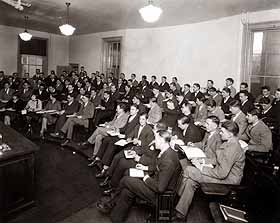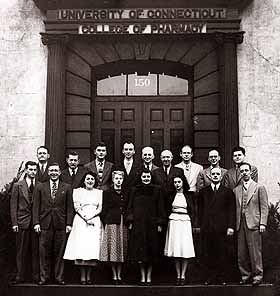|
This is an archived article. For
the latest news, go to the Advance
Homepage
For more archives, go to the Advance Archive/Search Page. |
||||
|
A Piece of UConn History:
Pharmacy Celebrates 75 Years The School of Pharmacy will celebrate two anniversaries this year: its 60th year with the University and the 75th anniversary of its founding.
A committee of the Connecticut Pharmaceutical Association voted in 1920 to recommend "that a College of Pharmacy be opened either independently or in conjunction with one of the large universities in the state of Connecticut." A state commission accepted the CPA recommendation and on June 3, 1921, Gov. Marcus Holcomb signed the bill that chartered the Connecticut College of Pharmacy. The pharmaceutical association decided in March 1923 that it should be an independent college and turned management over to a board of trustees. The pharmacy college opened in October 1925, under the leadership of its first dean, Dr. Gustavus Eliot of New Haven, offering a two-year course leading to the degree of Ph.G. (Graduate in Pharmacy). The entering Class of 1927 had 85 members. The course of study was extended to three years in 1927, and to a four-year program in 1932. In 1940, pharmacy college trustees and Dean Henry S. Johnson were notified that future accreditation of the college would be dependent on improving the college's financial condition and on becoming affiliated with a university program. Accrediting agencies for pharmacy education programs had insisted that the college be affiliated with a university before the re-accreditation process in 1942. The Connecticut Pharmaceutical Association also called for such an arrangement, because "the increased prestige resulting therefrom would attract better qualified young people to such a course." Also at issue was indebtedness. By late 1940, the college already had an association with the University of Connecticut. The college had asked UConn to assist in an appraisal of its non-scientific course work, and officials had broached the idea of affiliation. The University at the time was just completing a reorganization of its divisions into schools and colleges, following its establishment as a university in 1939. At the Jan. 15, 1941 meeting of UConn's Board of Trustees, President Albert N. Jorgensen presented a Jan. 10 letter from Curtis P. Gladding, president of the pharmacy college's board, requesting that it be "amalgamated or absorbed" by the University and outlining the concerns of the accrediting agencies. Wrote Gladding: "Altho (sic) we have operated very successfully as an independent institution for the past 16 years, as you will appreciate from what I have written above, our trustees feel that the future of the school would be more stable if we were part of a state university. A very large majority of the 70 or 80 colleges of pharmacy in this country are connected with state universities or other universities." UConn trustees instructed Jorgensen to appoint a faculty committee to study the pharmacy college's request. The committee's report was favorable and, by May 1941, the General Assembly had approved a bill that accepted the transfer of all assets of the Connecticut College of Pharmacy to the University of Connecticut and authorized the University to develop and implement a course in pharmacy. The legislation said the college would continue at the site in New Haven for a while, and noted that the personnel had been inducted into the State Personnel Organization. All 18 pharmacy college faculty became members of the University faculty. As of June 30, 1941, the pharmacy college had an enrollment of 165 students and an alumni group of nearly 500, spread throughout Connecticut and nearby states. On Sept. 16, 1941, the first pharmacy classes with the University of Connecticut began in New Haven. Ten years later, in 1951, pharmacy moved to a new building on the Storrs campus. It was designated a school in 1954. Mark J. Roy On Saturday, May 5, the School of Pharmacy will hold its 75th Anniversary Celebration in Room A120, New Chemistry Building, from 4 to 5:30 p.m. |


